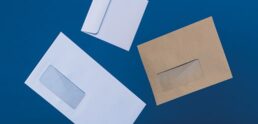Gummed Envelopes
A water soluble gum is the most common sealing method, and one that is always used for mailing envelopes.
This requires moistening the layer of adhesive along the envelope flap and pressing it shut.
The gum used on these envelopes is water soluble and typically made from a blend of synthetic resin and dextrin, therefore it is biodegradable.
Gummed envelopes are the only envelopes that are suitable for automatic machine inserting, where the sealing can be performed automatically by the mailing machine.
As long as these envelopes are stored in the correct conditions, they should last for a number of years.
 Bookwraps
Bookwraps Corrugated Mailers
Corrugated Mailers Triangle Mailing Tubes
Triangle Mailing Tubes HP (High Protection) Wraps
HP (High Protection) Wraps Nature First Padded Mailers
Nature First Padded Mailers Kraft Mailing Bags
Kraft Mailing Bags Stay-Flat Mailers
Stay-Flat Mailers OP Cardstock Envelopes
OP Cardstock Envelopes Mug Mailers
Mug Mailers One-Touch Boxes
One-Touch Boxes Presentation Folders
Presentation Folders Keepsake Boxes
Keepsake Boxes




